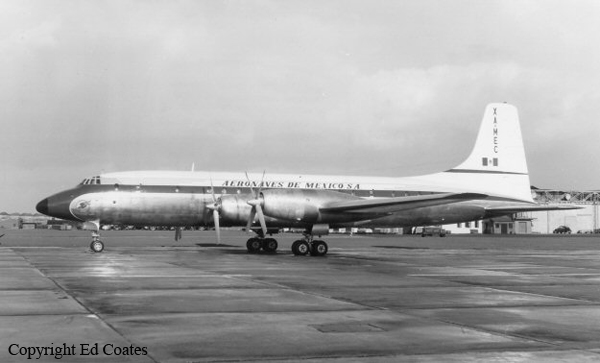Country
Crash of a Bristol 175 Britannia 253F in Billerica: 7 killed
Date & Time:
Feb 16, 1980 at 1416 LT
Registration:
G-BRAC
Survivors:
Yes
Schedule:
Boston - Shannon - Luton
MSN:
13448
YOM:
1959
Flight number:
RY103
Crew on board:
5
Crew fatalities:
Pax on board:
3
Pax fatalities:
Other fatalities:
Total fatalities:
7
Captain / Total hours on type:
7400.00
Copilot / Total hours on type:
4760
Aircraft flight hours:
21963
Aircraft flight cycles:
8310
Circumstances:
The four engine airplane departed Boston-Logan Airport runway 33L at 1408LT on a cargo flight to Luton via Shannon, carrying eight occupants and a load of computers. Initial climb was completed in poor weather conditions with a visibility reduced to 800 meters due to snow showers, fog and also severe icing conditions. At an altitude of 1,700 feet, the airplane started an uncontrolled descent then contacted trees and crashed in a wooded area located in Billerica, about 17 miles northwest of Boston-Logan Airport. A crew member was seriously injured while seven other occupants were killed.
Probable cause:
Degraded aerodynamic performance beyond the flight capabilities of the aircraft resulting from an accumulation of ice and snow on the airframe before take-off and a further accumulation of ice when the aircraft was flown into moderate to severe icing conditions following take-off. Contributing were encounters with windshear, downdraughts and turbulence during the climb. The failure of the flight crew to obtain an adequate preflight weather briefing and the failure of the National Weather Service to advise the crew of a SIGMET for severe icing conditions were also contributing factors.
Final Report:



Crash of a Bristol 175 Britannia 253 in Shannon
Date & Time:
Sep 30, 1977
Registration:
EI-BBY
Survivors:
Yes
MSN:
13455
YOM:
1959
Crew on board:
4
Crew fatalities:
Pax on board:
2
Pax fatalities:
Other fatalities:
Total fatalities:
0
Circumstances:
On final approach to Shannon Airport runway 24, at an altitude of 300 feet, the crew encountered severe vibrations. The captain decided to initiate a go-around but the aircraft continued to descent until it struck the ground short of runway threshold. Upon impact, the right wing and the undercarriage were torn off and the aircraft came to rest in flames in a pasture. All six occupants escaped with minor injuries while the aircraft was damaged beyond repair.


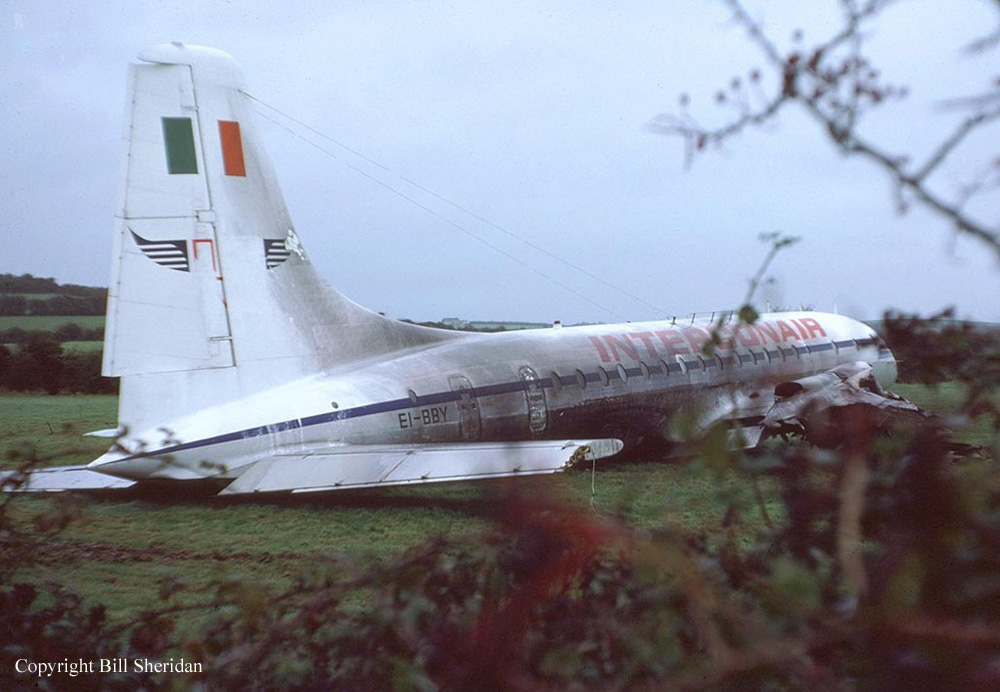

Crash of a Bristol 175 Britannia 312F in Buenos Aires
Date & Time:
Jul 12, 1970
Registration:
LV-JNL
Survivors:
Yes
MSN:
13230
YOM:
1957
Crew on board:
4
Crew fatalities:
Pax on board:
8
Pax fatalities:
Other fatalities:
Total fatalities:
0
Circumstances:
The approach to Buenos Aires-Ezeiza-Ministro Pistarini Airport was completed in a near zero visibility due to thick fog. On short final, the pilot-in-command failed to realize his altitude was too low when the airplane struck an ILS antenna located short of runway 04 threshold. After the impact, the airplane nosed down, struck the ground and slid for about 600 meters before coming to rest. All 12 occupants were injured and the airplane was damaged beyond repair.
Probable cause:
It was determined that the crew continued the approach below minima weather conditions and below the glide, causing the airplane to struck obstacles on short final. The captain decided to go around after the impact with the ILS antenna but it was too late.
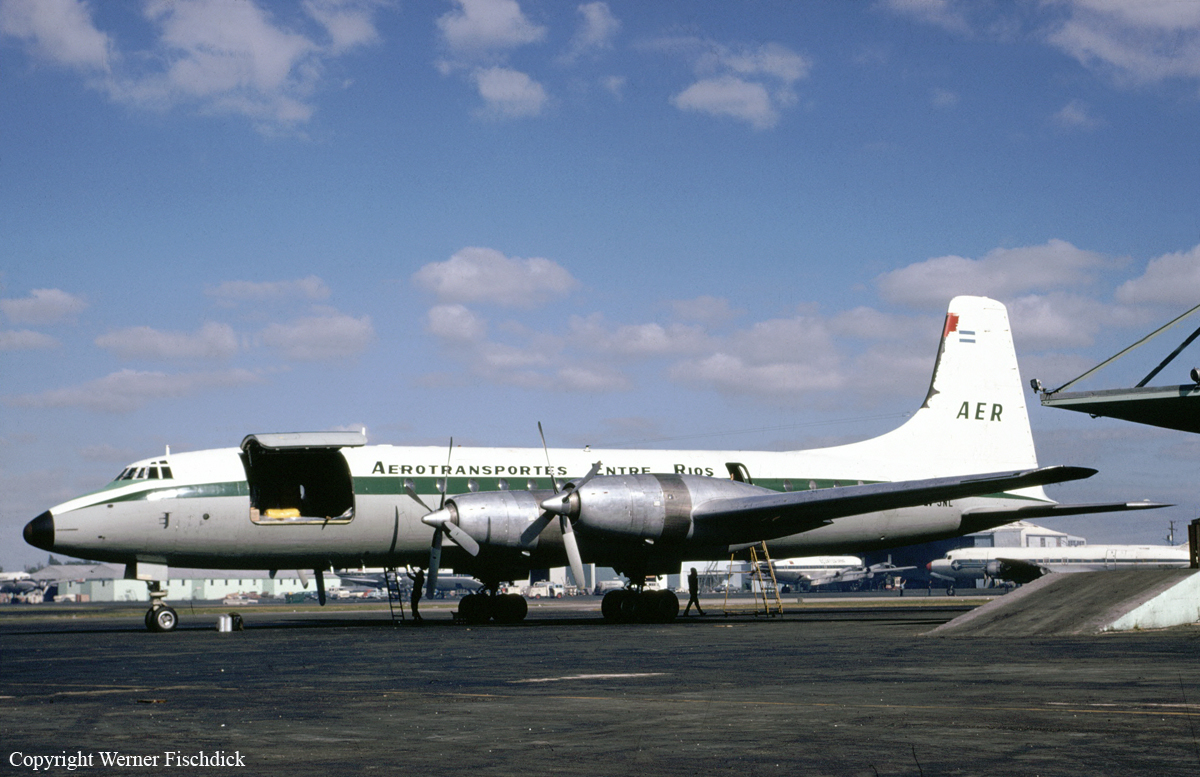
Crash of a Bristol 253 Britannia C.1 in Aden
Date & Time:
Oct 12, 1967
Registration:
XL638
Survivors:
Yes
Schedule:
London - Bahrain - Aden
MSN:
13400
YOM:
1959
Crew on board:
0
Crew fatalities:
Pax on board:
0
Pax fatalities:
Other fatalities:
Total fatalities:
0
Circumstances:
After touchdown at Aden-Khormaksar Airport, the four engine airplane encountered difficulties to stop within the remaining distance and overran. It lost its undercarriage and came to rest in shallow water. There were no casualties but the aircraft was written off.
Probable cause:
Failure of the reverse systems after touchdown for undetermined reason.
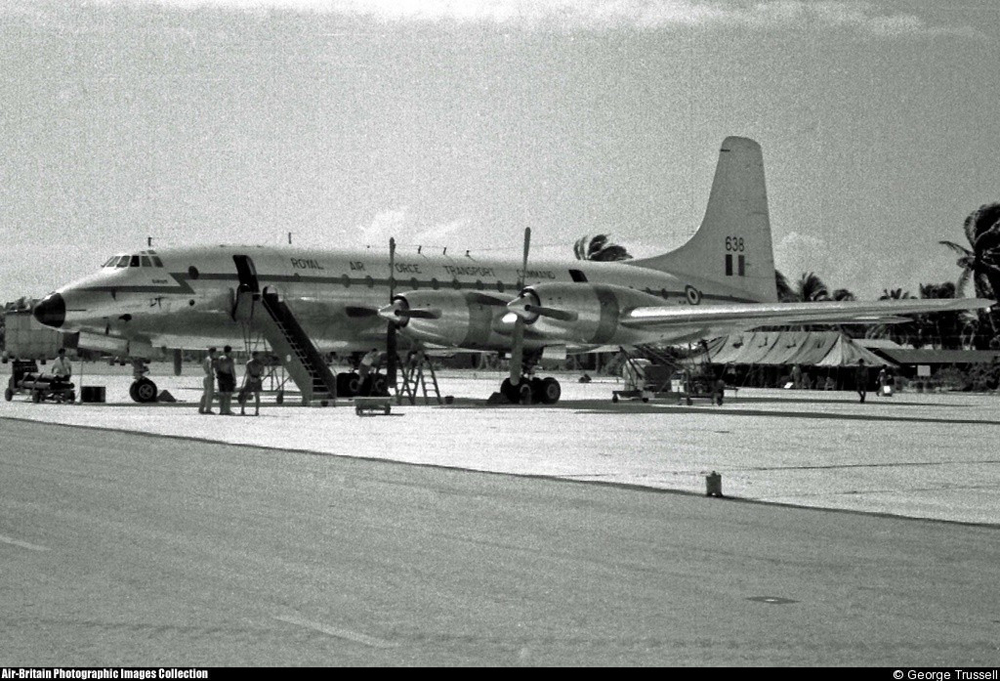
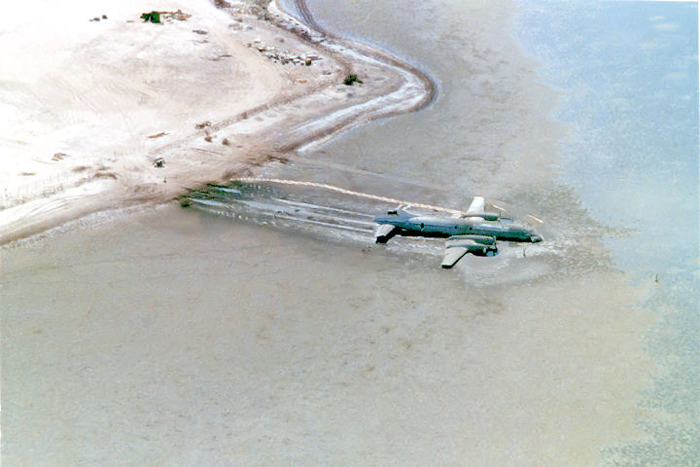
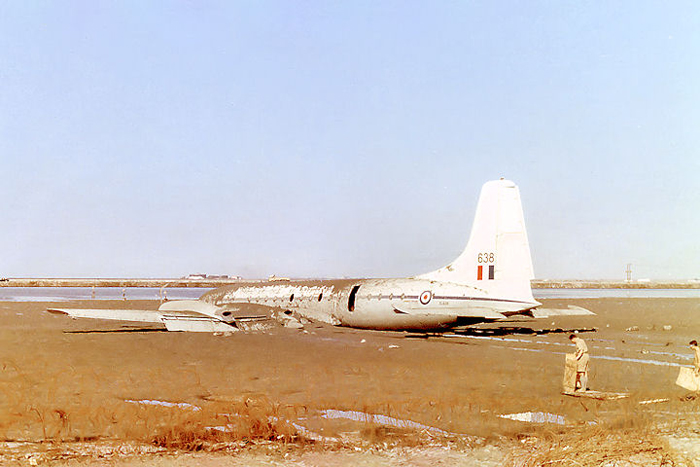
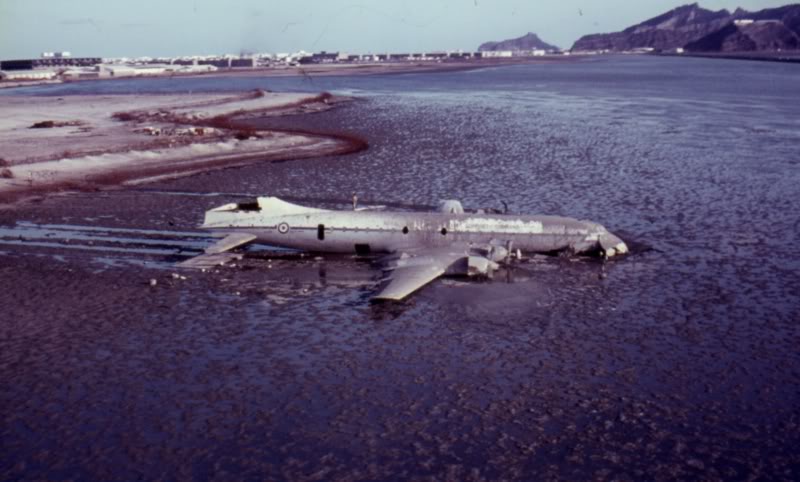
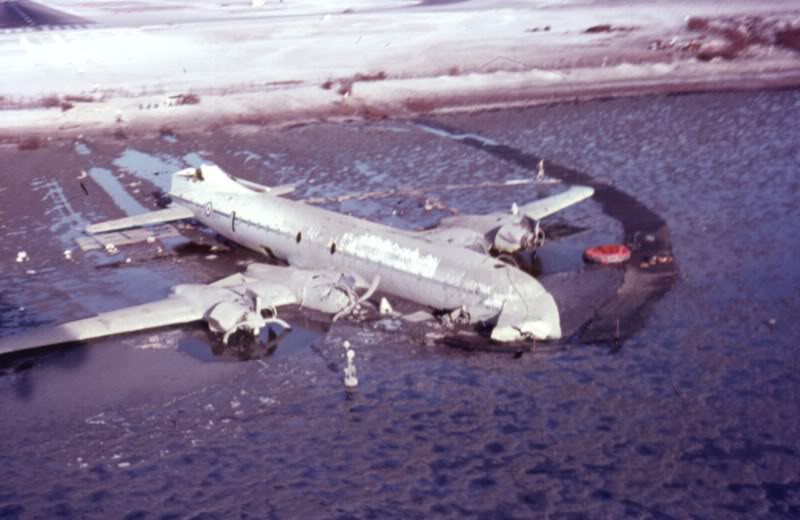
Crash of a Bristol 175 Britannia 313 in Nicosia: 126 killed
Date & Time:
Apr 20, 1967 at 0113 LT
Registration:
HB-ITB
Survivors:
Yes
Schedule:
Bangkok - Colombo - Bombay - Cairo - Zurich - Basel
MSN:
13232
YOM:
1957
Crew on board:
10
Crew fatalities:
Pax on board:
120
Pax fatalities:
Other fatalities:
Total fatalities:
126
Captain / Total hours on type:
1493.00
Copilot / Total hours on type:
49
Aircraft flight hours:
20632
Aircraft flight cycles:
6780
Circumstances:
The aircraft was on a non-scheduled flight from Bangkok to Base1 with scheduled stops at Colombo, Bombay and Cairo. The aircraft departed Bombay for Cairo on 19 April at 1312 hours GMT, with 11 hours and 10 minutes of fuel endurance and an estimated flight time for Cairo of 9 hours. According to the flight plan time, it was due to arrive in Cairo at 2212 hours. The alternate airport for the above sector was given as Beirut. At 2215 hours the aircraft was heard calling Nicosia but, due to distance and height, two-way communication with Nicosia on VHF could not be established until 2234 hours. In the meantime a message was received from Beirut advising Nicosia that the aircraft had entered the Nicosia FIR and had reported over position Red 18A at 2229 hours. From the Area Control radiotelephony tape recording, it is evident that the actual weather conditions at Nicosia at 2145 hours and 2245 h~.:rs were passed to the aircraft at 2238 hours and 2254 hours respectively. Details of the latter actual weather were passed again to the aircraft at 2300 hours by Approach Control. The aircraft came over the field at 2306 hours and was cleared for a right- hand circuit. At 2310 hours, when over the threshold of runway 32, the aircraft was slightly high and the captain decided to overshoot. He informed the tower and was cleared for a left-hand circuit. He further informed the tower that he would carry out a low circuit. The aircraft was momentarily seen by the controller during its final approach and the glare of its landing lights was visible through the low cloud when it made a pass over the runway in use and disappeared from view over the upwind end of the runway in the low cloud to the north-west. On his second attempt to land and while executing a low circuit, the aircraft collided with the ground at 0113LT, 3,5 km short of runway threshold. A crew member and three passengers were seriously injured while 126 other occupants were killed. The aircraft was totally destroyed by impact forces and a post crash fire.
Probable cause:
The accident resulted from an attempt to make an approach at a height too low to clear rising ground. The following findings were reported:
- The reason why Captain Muller chose to land at Nicosia instead of Beirut which was on his flight plan and where the weather conditions were much better than Nicosia cannot be determined,
- From date available concerning Capt. H.M. Day, it is obvious that he must be considered as a pilot under training in view of his limited hours on Britannias and as neither his Swiss nor his British licence was valid,
- Under these conditions the flight time limitations for two pilots for turboprop aircraft had been exceeded by 2 hours and 47 minutes at the time of the accident. Furthermore this excess would be augmented to 4 hours and 17 minutes, taking into consideration the fact that the company considered the if hour preceding the scheduled take-off time on duty for flight time limitation purposes,
- From the tape recordings it has been possible to establish,with the help of Globeair technical personnel who could recognize the speech recorded,the fact that during the flight of HB-ITB from Cairo to Nicosia, Capt. Muller and F/O Hippemeyer were in the flight deck,
- From the data made available it can be said that the aircraft was airworthy and properly maintained and correctly loaded in Bombay for the flight,
- No evidence of pre-crash failure was discovered and the radiotelephony contact with the tower from initial contact and up to the time of the crash was normal,
- After overshoot procedures the pilot decided to make a visual low circuit,
- The company's weather minima for circling at Nicosia are given as 1 000 ft cloud base and 4 km visibility. Using the Nicosia NDB for runway 27, the minima are 500 ft cloud base and 2.4 km visibility.
- The reason why Captain Muller chose to land at Nicosia instead of Beirut which was on his flight plan and where the weather conditions were much better than Nicosia cannot be determined,
- From date available concerning Capt. H.M. Day, it is obvious that he must be considered as a pilot under training in view of his limited hours on Britannias and as neither his Swiss nor his British licence was valid,
- Under these conditions the flight time limitations for two pilots for turboprop aircraft had been exceeded by 2 hours and 47 minutes at the time of the accident. Furthermore this excess would be augmented to 4 hours and 17 minutes, taking into consideration the fact that the company considered the if hour preceding the scheduled take-off time on duty for flight time limitation purposes,
- From the tape recordings it has been possible to establish,with the help of Globeair technical personnel who could recognize the speech recorded,the fact that during the flight of HB-ITB from Cairo to Nicosia, Capt. Muller and F/O Hippemeyer were in the flight deck,
- From the data made available it can be said that the aircraft was airworthy and properly maintained and correctly loaded in Bombay for the flight,
- No evidence of pre-crash failure was discovered and the radiotelephony contact with the tower from initial contact and up to the time of the crash was normal,
- After overshoot procedures the pilot decided to make a visual low circuit,
- The company's weather minima for circling at Nicosia are given as 1 000 ft cloud base and 4 km visibility. Using the Nicosia NDB for runway 27, the minima are 500 ft cloud base and 2.4 km visibility.
Final Report:
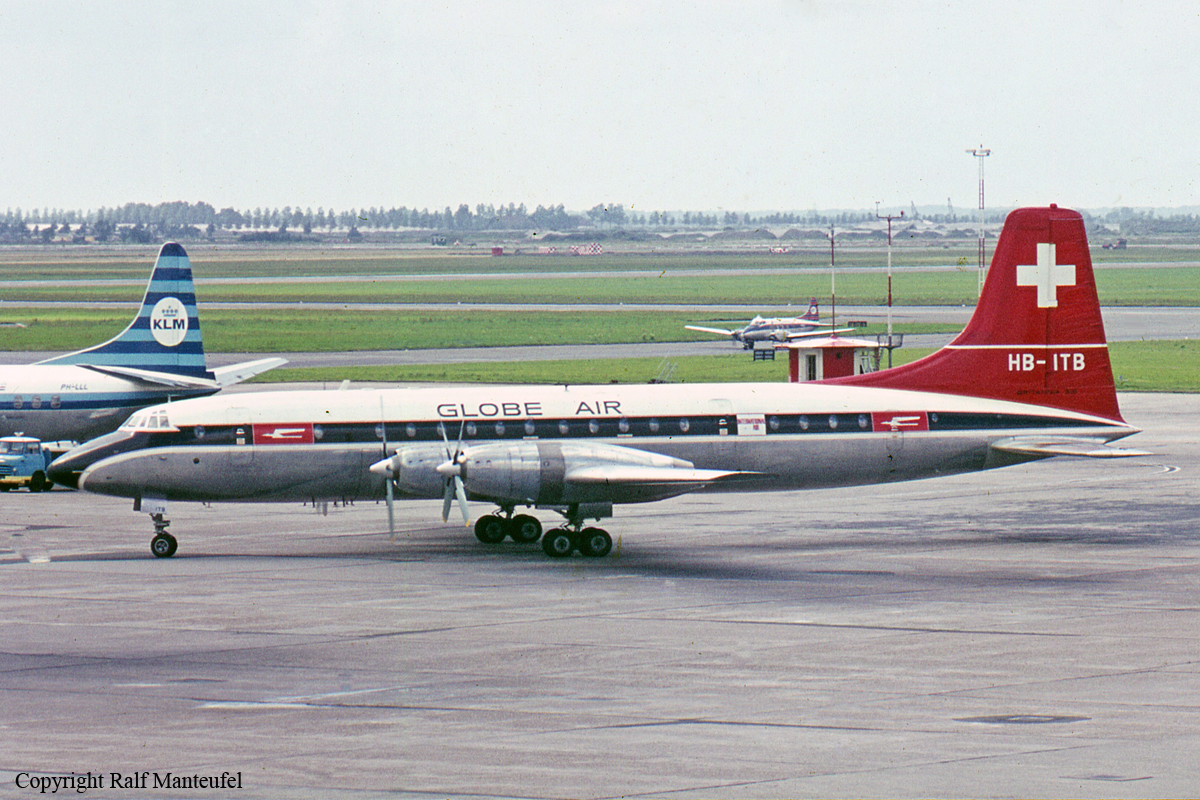
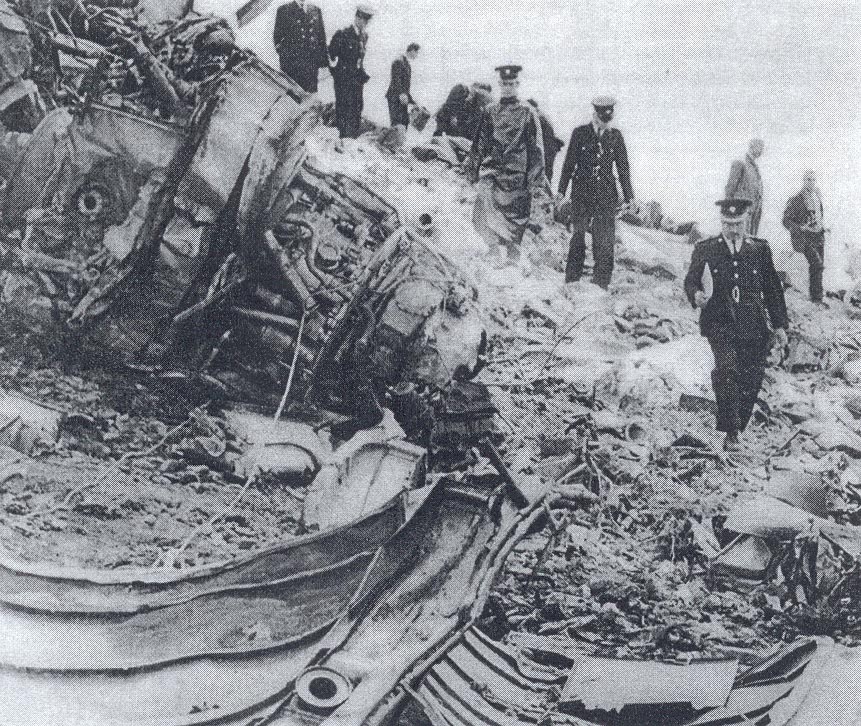


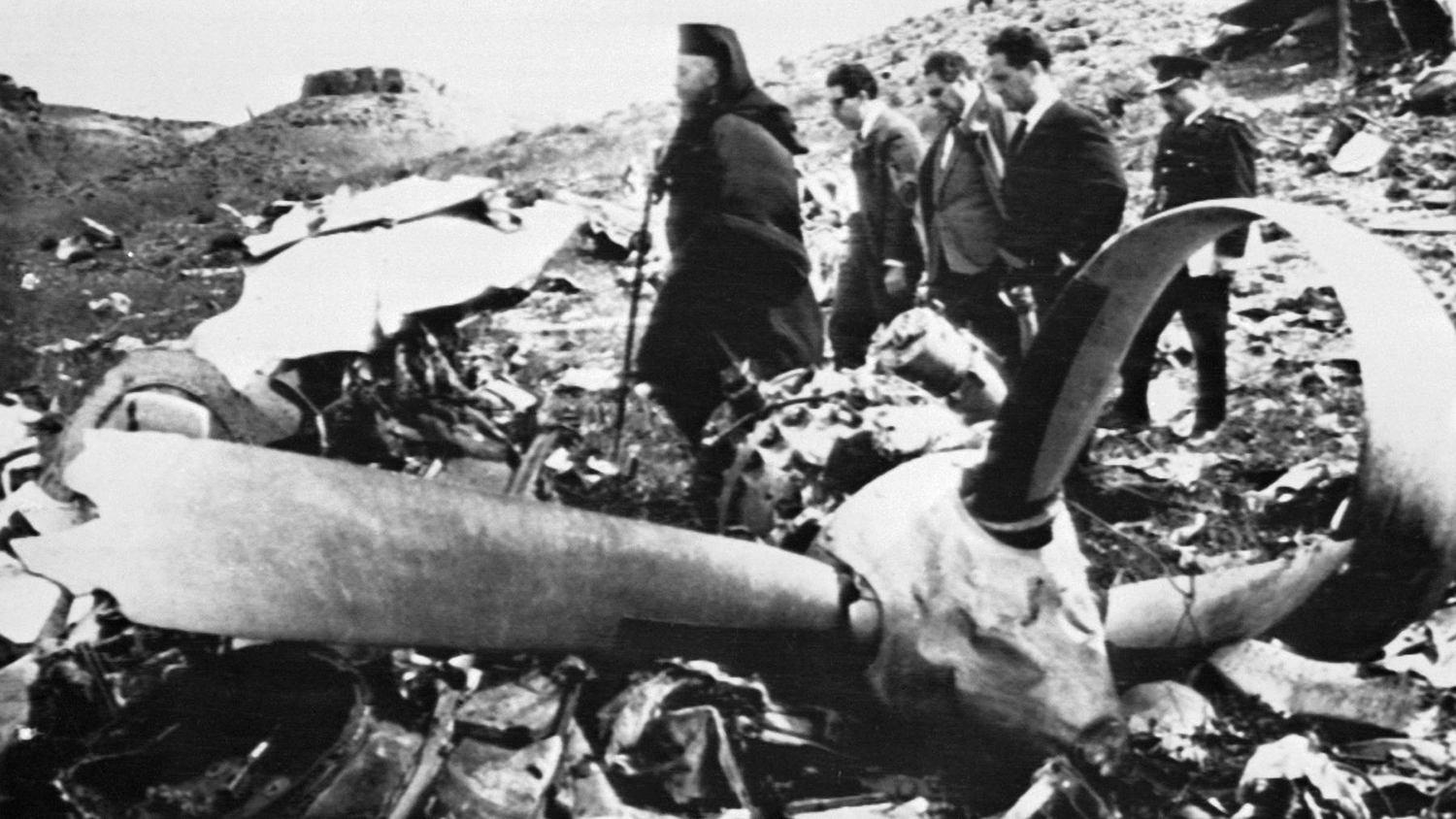
Crash of a Bristol 175 Britannia 308F in Manston
Date & Time:
Apr 20, 1967
Registration:
G-ANCG
Survivors:
Yes
Schedule:
London - Kuwait City
MSN:
12923
YOM:
1959
Crew on board:
11
Crew fatalities:
Pax on board:
54
Pax fatalities:
Other fatalities:
Total fatalities:
0
Captain / Total hours on type:
1874.00
Copilot / Total hours on type:
3840
Aircraft flight hours:
10682
Circumstances:
Shortly after takeoff from London-Heathrow Airport, while climbing, the undercarriage wouldn't lock up after takeoff, so the crew recycled the gear a couple of times. On the third attempt, the bogie (which was not rotating in the right sequence) fouled the main hydraulic jack fracturing the attachment bolt of the shuttle valve for the main and emergency 'down' hydraulic lines. All hydraulic fluid escaped and the gear couldn't be extended anymore. In agreement with ATC, the captain decided to divert to Manston-Kent Airport where an emergency landing was carried out on a foamed runway. The airplane completed a belly landing and was damaged beyond repair while all 65 occupants escaped uninjured.
Probable cause:
The undercarriage failed to lock down due to loss of the hydraulic fluid from the main and emergency systems. This resulted from fracture of the hydraulic lines consequent upon fouling of the port undercarriage retraction jack head by the bogie through incorrect setting up of the retraction sequence valve. The following findings were reported:
- The port main undercarriage retraction sequence valve, which was replaced before the flight, was not correctly set up,
- The undercarriage retraction test to check the operation of the sequence valve was carried out in such a way that the incorrect sequence of retraction resulting from the finding indicated in the previous paragraph was not detected,
- When the undercarriage was retracted after takeoff, the port bogie beam fouled the port main undercarriage retraction jack head,
- 'Recycling' the undercarriage resulted in the detachment of the main and emergency 'down' lines, and the loss of all hydraulic fluid and other fluids with which the system was replenished,
- None of the undercarriage units could be locked down and all collapsed during the landing.
- The port main undercarriage retraction sequence valve, which was replaced before the flight, was not correctly set up,
- The undercarriage retraction test to check the operation of the sequence valve was carried out in such a way that the incorrect sequence of retraction resulting from the finding indicated in the previous paragraph was not detected,
- When the undercarriage was retracted after takeoff, the port bogie beam fouled the port main undercarriage retraction jack head,
- 'Recycling' the undercarriage resulted in the detachment of the main and emergency 'down' lines, and the loss of all hydraulic fluid and other fluids with which the system was replenished,
- None of the undercarriage units could be locked down and all collapsed during the landing.
Final Report:

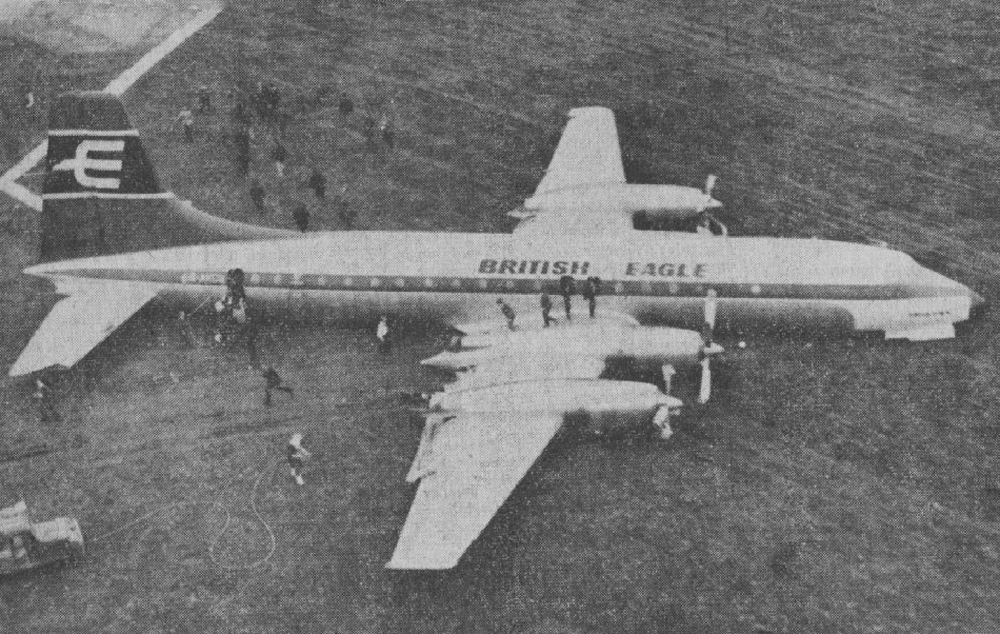
Crash of a Bristol 175 Britannia 102 in Ljubljana: 98 killed
Date & Time:
Sep 1, 1966 at 0047 LT
Registration:
G-ANBB
Survivors:
Yes
Schedule:
Luton – Ljubljana
MSN:
12903
YOM:
1955
Flight number:
BY105
Crew on board:
7
Crew fatalities:
Pax on board:
110
Pax fatalities:
Other fatalities:
Total fatalities:
98
Captain / Total hours on type:
517.00
Copilot / Total hours on type:
1200
Aircraft flight hours:
18444
Aircraft flight cycles:
5380
Circumstances:
Flight BY 105 was a non-scheduled international flight from Luton (England) to Ljubljana (Yugoslavia), for the transport of tourists. The aircraft took off from Luton at 2110 hours GMT on 31 August 1966, with a crew of 7 and 110 passengers. Before overflying the Yugoslav border, the crew contacted the Zagreb Area Control Centre. The radiocommunications were uninterrupted, and the crew received all necessary information and instructions. After overflying Klagenfurt, the crew contacted Ljubljana Aerodrome Control, and from that time on the radio communications were uninterrupted and continuous. The conversation between the crew spoken sometimes too fast and a trifle garbled, and the controller spoken without any difficulty to understand is contained in the transcript of the R/T tape recording. During the radiocommunications the controller supplied the crew with meteorological and other necessary landing information: "Wind is calm, visibility 5 kilometres, shallow fog aver the runway is forming now, clouds 218 strato-cumulus 1 800 metres. QNH 1011, QFE 968 millibars. Temperature 10 and dew point also 10 degrees. Runway will be 31. After Dolsko make left pattern holding, descend down to 4 500 by QNH, report inbound." The crew acknowledged receipt of the information with: "Roger. We have runway 31. Over Dolsko descend 4 500 in the holding pattern. The QNH 1 011." When the pilot asked the controller if the ILS was operating, the controller answered that he had radar contact at a position 20 NM southeast from the airport and advised the crew to make an ILS approach to runway 31, and to report after descending to 4 500 ft QNH. The crew acknowledged and reported they were at 4 500 ft and would call over Dolsko inbound for the outer marker and asked again if the ILS was operating and if it was serviceable. The controller answered affirmatively, adding that the ILS was working normally. He then gave the position "abeam Dol" and after that was acknowledged by the crew, he asked if they had contact with the runway. The crew confirmed that they had contact, and thereafter did not at any time indicate that they had lost contact, although it was implied by their request for a radar approach just before the accident occurred, and one minute later they reported having passed Dolsko continuing and descending towards runway 31. The controller acknowledged this information and requested the crew to "check final for runway 31", and gave the aircraft its position as 7 NM from touchdown on the centre line should be passing 3 300 ft and repeated "check final for runway 31'. The crew acknowledged this message and 1 1/2 minute later reported having passed the outer marker inbound. The controller issued clearance for landing and advised that he had set the approach and runway lights to maximum intensity. He then left the radar console and went to the light control console at the same time glancing towards the approach and the runway. He could not see the aircraft but the approach and runway lights were clearly visible. At that moment, the crew requested radar assistance. The controller returned to the radar console and started to supply them with radar information. After giving the crew two aircraft positions of 34 NM and 2 NM from touchdown, he observed that the aircraft signal was turning to the right and gave a correction of 3° left. Observing that the aircraft did not make any correction, the controller informed the crew that its position was 1 1/2 NM from the touchdown, and asked the pilot whether he was making a short right turn to the radio beacon Menges. The crew did not reply, and there was no further contact with them although the controller continued calling. Radar contact was lost at 0047 hours local time on 1 September 1966 (2347 hours GMT on 31 August 1966) and when fire and smoke was seen from the tower, the controller gave the alarm and took necessary emergency measures. The rescue services, after 15 minutes, found the crashed aircraft on fire, in a wood, 2.8 km southeast of the threshold of runway 31 and 0.7 km north of the runway extended centre line. A crew member and 18 passengers were evacuated to local hospital while 98 other occupants were killed. The aircraft was destroyed by impact forces and a post crash fire.
Probable cause:
The probable cause of the accident was that the pilot-in- command did not set his altimeter to the QFE-968 mb in accordance with the information passed by the controller. However, the whole approach to the airport was made as if the altimeter had been set to the QFE, and resuited in the approach being about 1 250 ft lower than procedural safety altitudes, so that the aircraft crashed into tree tops. The copilot's altimeter was set to the QNH and he did not notice that the aircraft's approach was too low, because although it was a moonlight night he could not distinguish any visual landmarks, which might have warned him of the low altitude, due to the nature of the tree covered terrain over which they were flying. As the altimeter error passed unnoticed by both pilots and because they were not carrying out cross-checks of the two altimeters in accordance with the relevant operations manual instruction, the error was not corrected by climbing to a safe altitude. This disregard of the procedures laid down in the checklists and operations manual for approach and landing, may be explained by the fact that the approach was carried out on a moonlight night in calm weather and with visibility of approximately 12 NM, which reduced the crew's concentration on following precisely the prescribed procedures and checks. The visual effect of the runway slope made the situation worse, giving the pilots a wrong impression of the aircraft's approach angle. The copilot's altimeter was found set to 1005.5 mb. The difference between the QNH and QFE passed to the aircraft was approximately equivalent to 1 000 ft, a figure which might have led to further confusion.
Final Report:


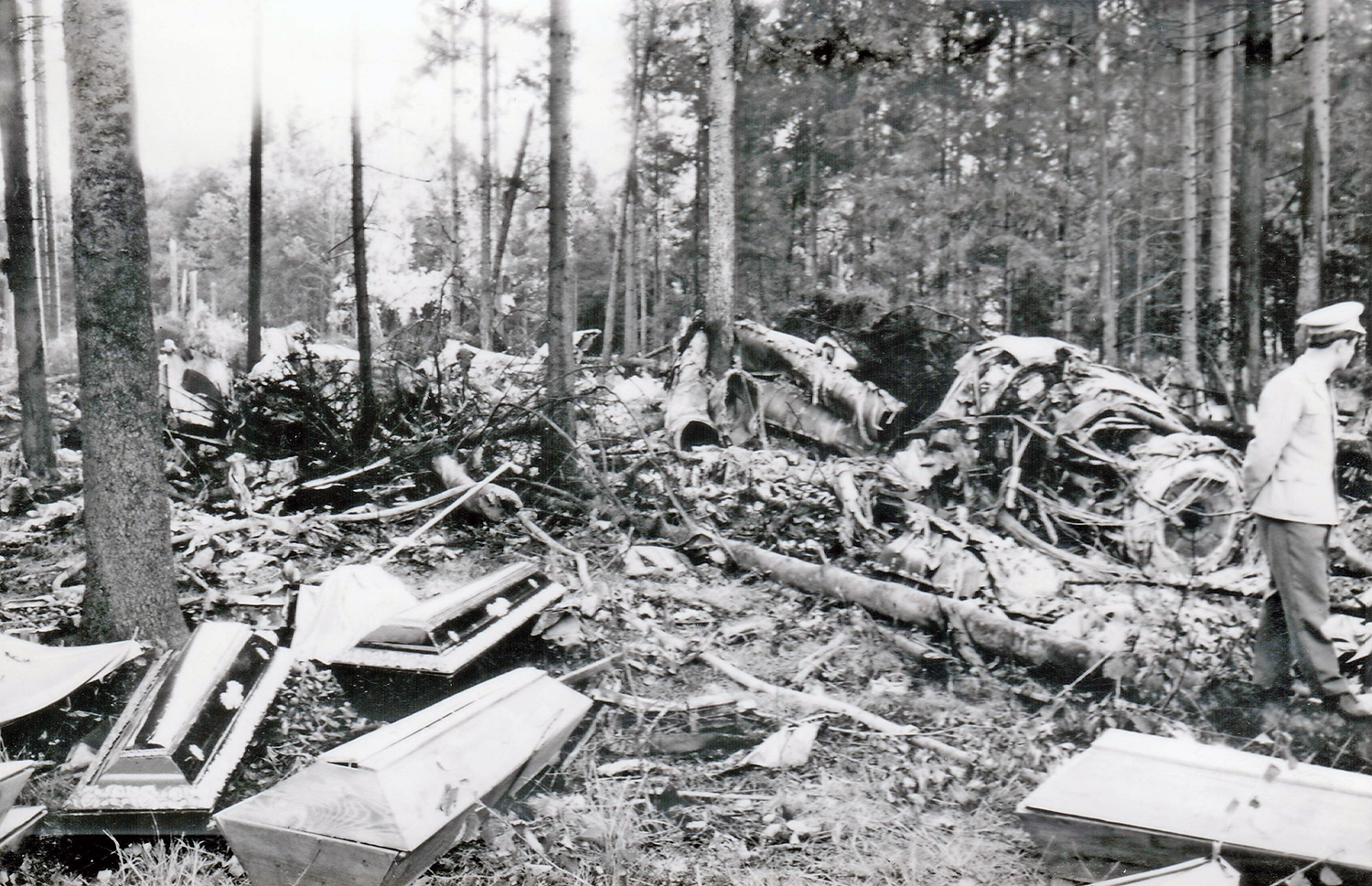


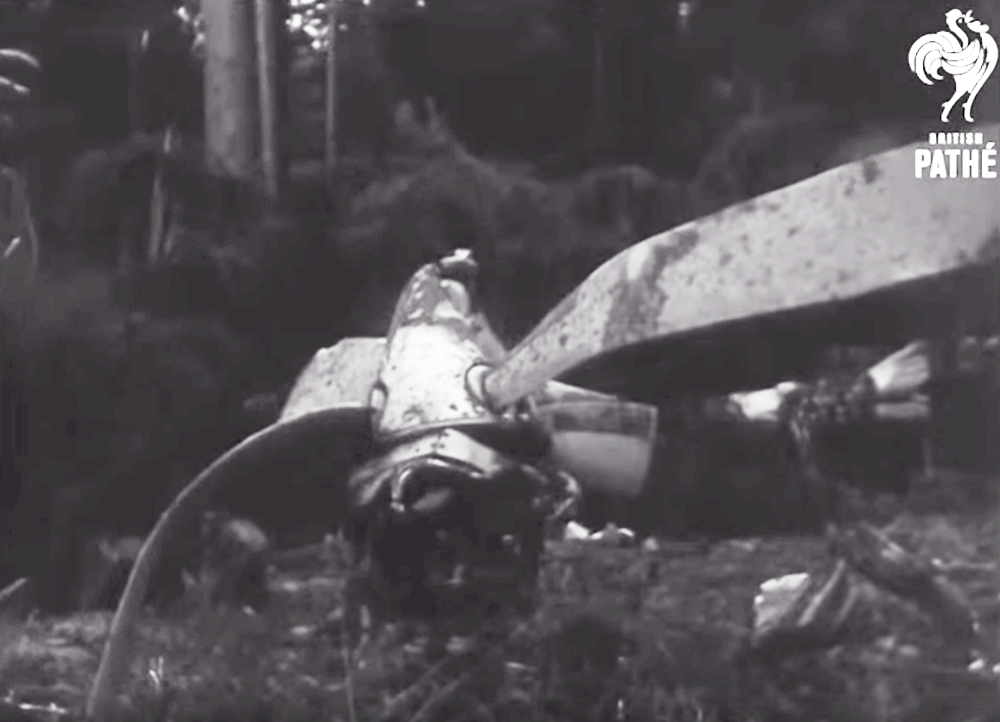

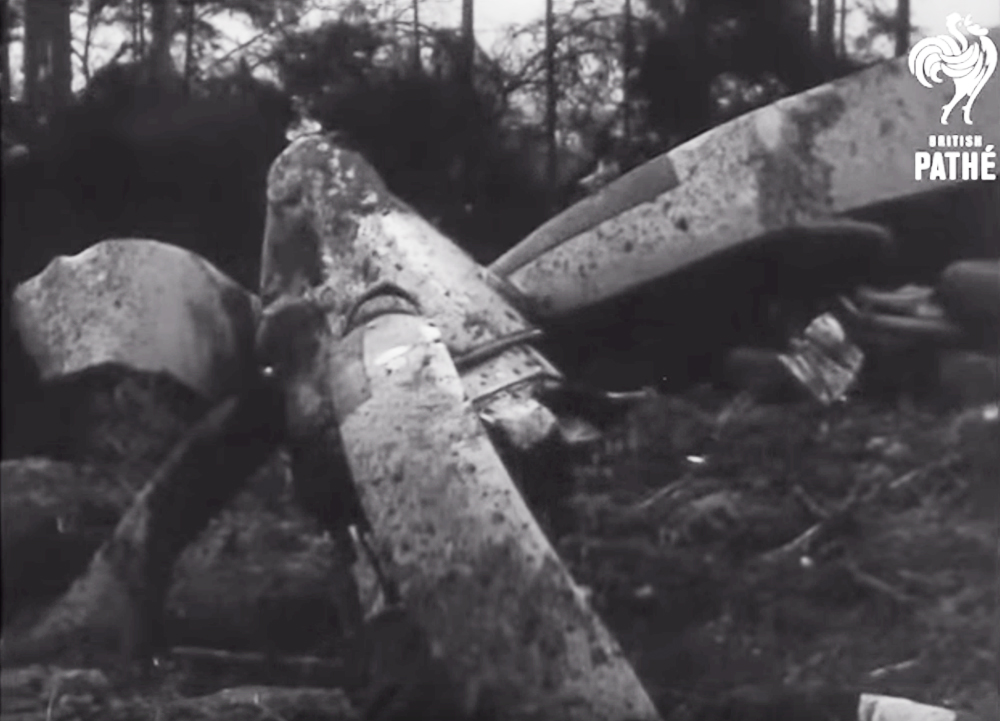

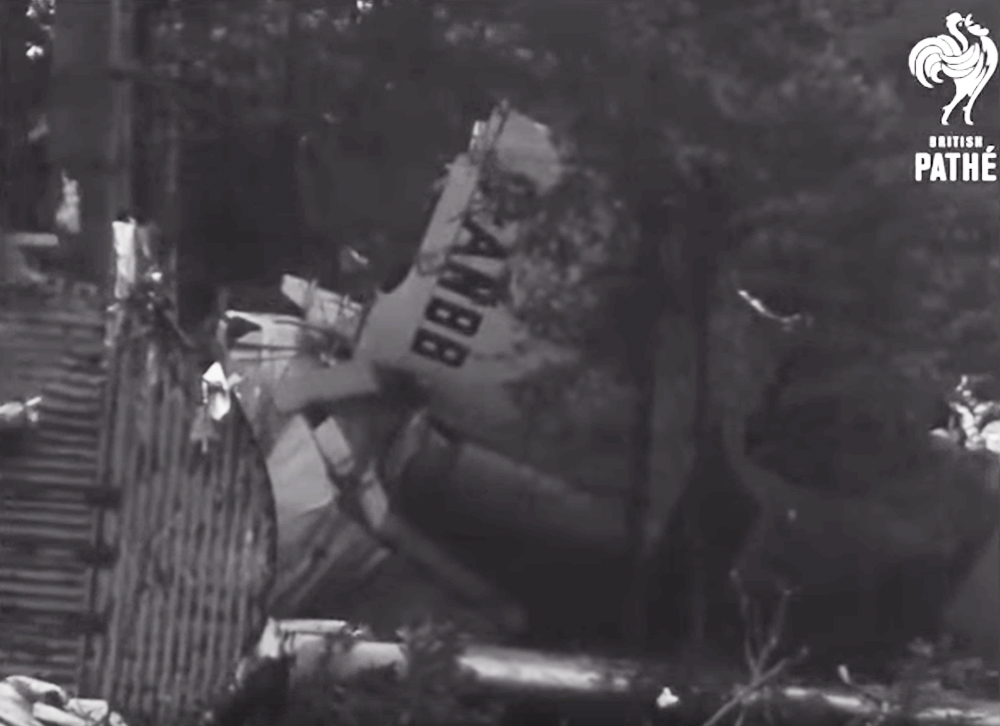
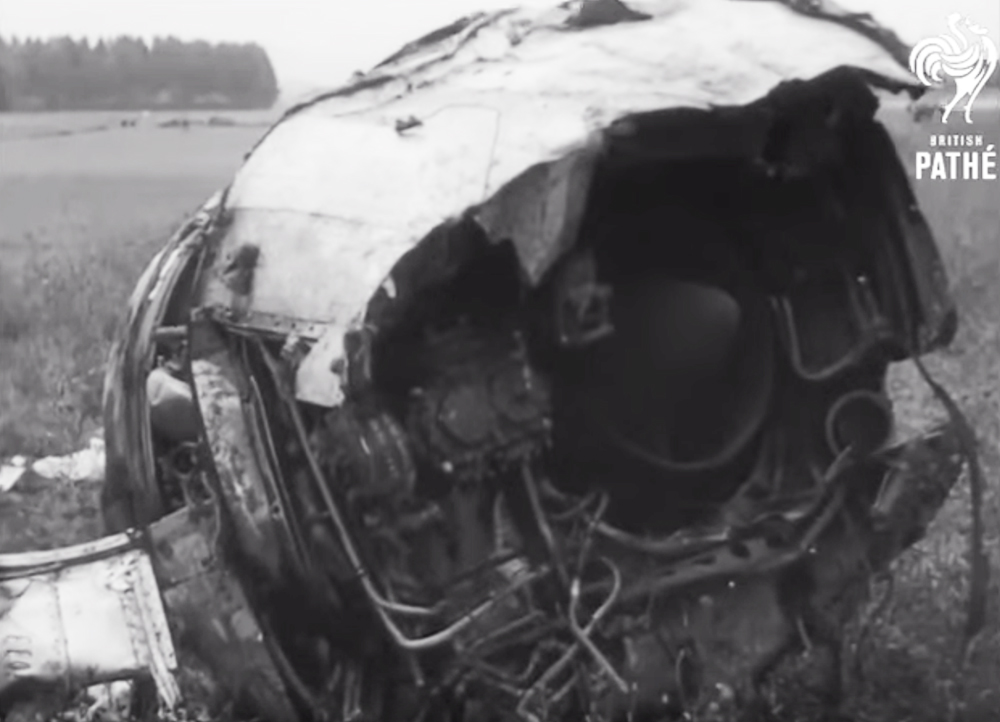

Crash of a Bristol 175 Britannia 302 in Tijuana
Date & Time:
Jul 9, 1965
Registration:
XA-MEC
Survivors:
Yes
Schedule:
Mexico City – Tijuana
MSN:
12918
YOM:
1957
Crew on board:
9
Crew fatalities:
Pax on board:
73
Pax fatalities:
Other fatalities:
Total fatalities:
0
Circumstances:
Following an uneventful flight from Mexico City, the crew started the descent to Tijuana-Rodriguez Airport when he encountered technical difficulties with one main gear that was not locked down. The captain decided to follow a holding pattern over Tijuana but few minutes later, he was forced to land due to fuel shortage. Upon touchdown, one of the main gear collapsed. The airplane slid for several dozen yards before coming to rest. While all 82 occupants were evacuated safely, the aircraft was considered as damaged beyond repair.
Probable cause:
Failure of a landing gear that was not locked down on landing.
